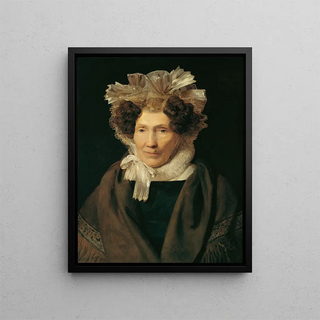Art print | Old woman with a white ribbon bonnet - Ferdinand Georg Waldmüller


View from behind

Frame (optional)
The artwork "Old woman with a white ribbon bonnet" by Ferdinand Georg Waldmüller is an iconic piece from the 19th century, delicately illustrating the sensitivity and humanity that characterize this Austrian artist's work. This painting, depicting an elderly woman with a deep, wise gaze, invites viewers to immerse themselves in a universe where beauty and melancholy meet. The delicacy of her facial features, the texture of her white ribbon bonnet, and the intimate atmosphere emanating from this piece make it a poignant representation of life and the passage of time. Waldmüller, through his talent, manages to capture a universal essence: that of human experience.
Style and uniqueness of the work
Waldmüller’s style is distinguished by striking realism, meticulous attention to detail, and a palette of soft colors that give his portraits a particular warmth. In "Old woman with a white ribbon bonnet," each brushstroke seems to tell a story, revealing the wrinkles that testify to the years lived and the emotions felt. The artist uses light with rare mastery, creating delicate shadows that enhance the depth of his model’s features. This piece is not limited to a simple representation; it evokes intimacy, a connection between the artist and his subject, where one can almost hear the whispered memories of this wise-looking woman. The composition is balanced, and the choice of colors, both sober and warm, contributes to the serene atmosphere emanating from this scene.
The artist and his influence
Ferdinand Georg Waldmüller, born in 1793, is considered one of the masters of Austrian realism. His work reflects the values and concerns of his time, while incorporating a deep psychological dimension. Influenced by the artistic movements of his era, he manages to stand out through his ability to humanize his subjects, to bring life to characters often marginalized by society. Waldmüller was able, through his portraits, to redefine perceptions of beauty, by emphasizing the unique and authentic qualities of his models.

Matte finish

View from behind

Frame (optional)
The artwork "Old woman with a white ribbon bonnet" by Ferdinand Georg Waldmüller is an iconic piece from the 19th century, delicately illustrating the sensitivity and humanity that characterize this Austrian artist's work. This painting, depicting an elderly woman with a deep, wise gaze, invites viewers to immerse themselves in a universe where beauty and melancholy meet. The delicacy of her facial features, the texture of her white ribbon bonnet, and the intimate atmosphere emanating from this piece make it a poignant representation of life and the passage of time. Waldmüller, through his talent, manages to capture a universal essence: that of human experience.
Style and uniqueness of the work
Waldmüller’s style is distinguished by striking realism, meticulous attention to detail, and a palette of soft colors that give his portraits a particular warmth. In "Old woman with a white ribbon bonnet," each brushstroke seems to tell a story, revealing the wrinkles that testify to the years lived and the emotions felt. The artist uses light with rare mastery, creating delicate shadows that enhance the depth of his model’s features. This piece is not limited to a simple representation; it evokes intimacy, a connection between the artist and his subject, where one can almost hear the whispered memories of this wise-looking woman. The composition is balanced, and the choice of colors, both sober and warm, contributes to the serene atmosphere emanating from this scene.
The artist and his influence
Ferdinand Georg Waldmüller, born in 1793, is considered one of the masters of Austrian realism. His work reflects the values and concerns of his time, while incorporating a deep psychological dimension. Influenced by the artistic movements of his era, he manages to stand out through his ability to humanize his subjects, to bring life to characters often marginalized by society. Waldmüller was able, through his portraits, to redefine perceptions of beauty, by emphasizing the unique and authentic qualities of his models.






